In 2026, Parental Monitoring Laws have become one of the most discussed legal topics among families and tech users worldwide. As smartphones, location tracking, and AI-based monitoring grow more common, parents are facing a difficult balance between protecting their child’s safety and respecting digital privacy rights. Governments in the U.S., Europe, and Asia have tightened child-data regulations, introducing new age-of-consent rules and heavier penalties for misuse. This guide explains what every parent should know before using a phone tracker app, how to stay compliant, what counts as “legal monitoring,” and why 2026 marks a turning point in the future of digital parenting. Whether you live in California, Singapore, or UAE, understanding these laws is now essential for safe, responsible family technology use.
Contents
- 1 1. Introduction
- 2 2. Understanding Parental Monitoring Laws in 2026
- 3 3. Legal Boundaries for Using a Phone Tracker App
- 4 4. Key Differences Between Parental Rights and Child Privacy
- 5 5. Country-by-Country Comparison of Parental Monitoring Laws 2026
- 6 6. Real-World Cases and Legal Lessons (2023 – 2026)
- 7 7. How to Stay Compliant When Using a Phone Tracker App
- 8 8. Future Trends in Parental Monitoring Laws (2026 – 2030)
- 9 FAQs – Parental Monitoring Laws 2026
- 10 Conclusion – Why Parental Monitoring Laws Matter in 2026
1. Introduction
Not long ago, tracking your child’s phone seemed like a simple act of care. Today, it’s a matter of legal interpretation. Around the world, Parental Monitoring Laws are evolving rapidly as societies debate how far parental rights should go in the digital age. While parents want to keep their children safe from online threats and real-world risks, lawmakers are emphasizing the importance of digital autonomy and consent for minors.
By 2026, many countries have rewritten their regulations to define clear boundaries on how phone tracker apps can collect, process, and store a child’s personal data. These updates don’t just affect developers or tech companies, they directly impact every parent who installs a tracking app on their child’s device. Failing to understand local rules could mean breaking privacy laws without realizing it.
This article offers a practical, region-by-region breakdown of the newest parental monitoring standards, real-world examples, and compliance tips. You’ll learn how to use a phone tracker legally, protect your child’s privacy, and stay informed about what changes are coming next in 2026 and beyond.

2. Understanding Parental Monitoring Laws in 2026
In 2026, Parental Monitoring Laws define the fine line between protection and privacy. These laws regulate how parents can legally track or monitor their child’s phone without crossing into unlawful surveillance. The goal is to protect children online while recognizing their growing right to digital autonomy.
Technology has changed what “monitoring” means. It’s no longer just checking texts, it involves AI-based location tracking, app usage control, and data analytics. Because these tools collect sensitive information, global regulators now demand stricter compliance, encryption, and user consent.
Definition and Scope
Parental Monitoring Laws set limits on when and how tracking can occur. They allow parents to use approved monitoring apps for safety — locating a lost phone, filtering harmful content, or managing screen time — but prohibit hidden or non-consensual surveillance. The emphasis is on responsible parental use, verified consent, and transparent data handling.
Global Shifts Since 2020
From COPPA in the U.S. to GDPR-Kids in Europe and PDPA in Asia, child-data laws have expanded rapidly. Many now require that both parents and children understand what data is collected. Violating these rules — even unintentionally — can lead to fines or legal disputes. In 2026, compliance has become part of responsible parenting itself.
Why 2026 Is a Turning Point
2026 marks a global reset in digital parenting. Governments are synchronizing privacy frameworks — introducing COPPA 2.0, the EU Digital Services Act, and new Asian privacy codes — all emphasizing consent and transparency. For the first time, Parental Monitoring Laws worldwide share one goal: ensuring safety without violating trust.
Comparison Table 1 – Legal vs Illegal Parental Monitoring (2026 Standards)
| Criteria | Legal Monitoring (Compliant with Parental Monitoring Laws) | Illegal Monitoring (Privacy Violation) |
|---|---|---|
| Purpose | Child safety, education, or device recovery | Control, spying, or punishment |
| Transparency | Child informed or consented | Hidden or deceptive tracking |
| Data Type | Minimal data: location, usage time | Full message or media capture |
| Consent | Documented or verified digitally | None or forged consent |
| Security | Encrypted, stored locally | Unsecured, third-party data sharing |
| Duration | Limited retention, regular deletion | Continuous, indefinite tracking |
| Legal Outcome | Fully compliant with Parental Monitoring Laws | Subject to fines, civil penalties, or lawsuits |
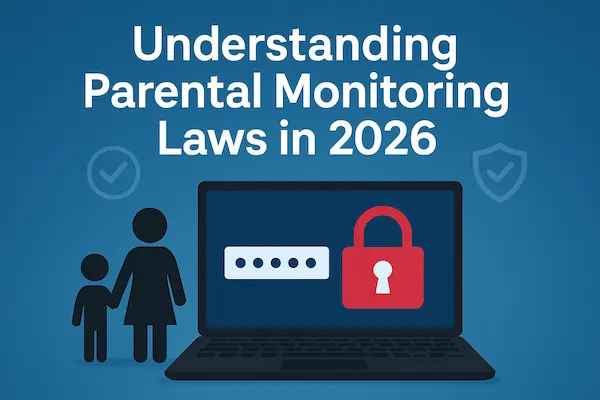
3. Legal Boundaries for Using a Phone Tracker App
In 2026, using a phone tracker app is not just a parenting choice, it’s a legal responsibility. Under modern Parental Monitoring Laws, parents can monitor a child’s device only when it serves a clear protective purpose, and data collection complies with privacy regulations. Unauthorized or secret tracking is now treated as a privacy violation in many countries.
1. Consent and Age Requirements
Most regions define a “digital age of consent”, the age at which a child must agree to data tracking.
-
In the U.S., the updated COPPA 2.0 enforces parental consent for users under 13.
-
The EU’s GDPR-Kids extends this protection to 16.
-
Across Asia, nations like Singapore, India, and Vietnam now require both parental approval and child awareness before any phone tracking occurs.
These regulations ensure that monitoring is cooperative, not coercive.
2. Data Privacy and Compliance
Every app handling minors’ data must follow strong encryption, transparency, and deletion protocols. Laws such as GDPR, PDPA, and India’s PDP Act mandate that parental tracking apps store data securely and disclose how it’s used. Failing to do so can lead to fines reaching millions of dollars or license suspensions.
Responsible parents are advised to use verified apps that clearly display compliance certifications and privacy guarantees.
3. Cross-Border and Legal Risks
With global mobility, families often use trackers across countries, yet Parental Monitoring Laws differ widely. What’s legal in one nation may violate privacy in another. Parents traveling or living abroad must check local data-transfer rules to avoid breaching international privacy frameworks.
In 2026, ignorance is no defense. Legal awareness is part of ethical parenting.
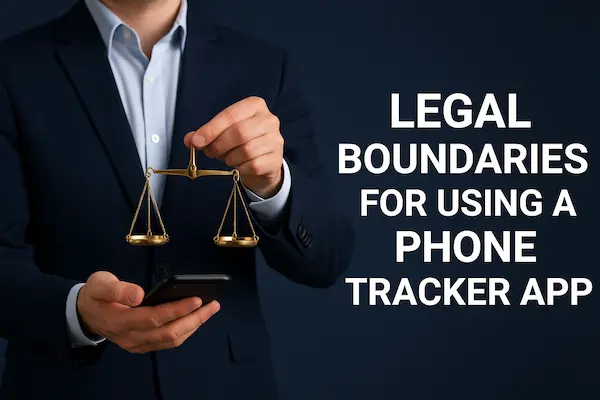
4. Key Differences Between Parental Rights and Child Privacy
Modern Parental Monitoring Laws are built on one central tension: how to protect children without violating their privacy. In 2026, this debate has reached classrooms, courts, and family homes worldwide. Parents have both the duty to safeguard and the obligation to respect boundaries, especially as minors gain stronger digital rights under new international privacy acts.
1. Legal vs. Ethical Monitoring
Legally, parents can supervise a child’s phone use for safety or education purposes. Ethically, however, they must avoid constant or hidden surveillance. Parental Monitoring Laws now encourage “reasonable monitoring,” meaning data collection must be transparent, limited, and directly linked to protection. Tracking without disclosure can be considered harassment or emotional intrusion in many jurisdictions.
2. Parental Rights in Custody and Education
Family and education laws intersect with digital rights. Courts increasingly view parental tracking during custody disputes as potential overreach, especially if one parent uses it to control the other. Schools, too, are adapting to privacy-first rules, requiring explicit consent before sharing a student’s device location or usage data. The goal is to ensure parental guidance supports development, not control.
3. The Digital Age of Consent
By 2026, many regions have introduced a “digital age of consent”, granting teenagers limited autonomy over their personal data. For example, European teens aged 16 can refuse monitoring apps if not essential for safety. This shift redefines parenting from authority to partnership, where trust becomes the strongest layer of digital protection.
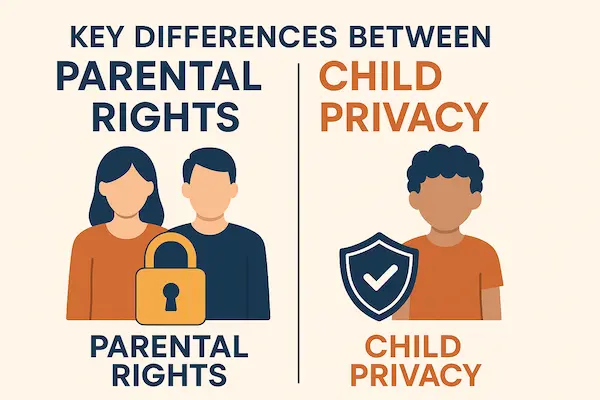
5. Country-by-Country Comparison of Parental Monitoring Laws 2026
In 2026, Parental Monitoring Laws vary widely between regions, reflecting cultural attitudes toward privacy and family responsibility. While most countries agree on the need to protect minors online, they differ in how much control parents are legally allowed to exercise. Understanding these distinctions is essential before using any phone tracker app internationally.
Global Overview
The United States continues to lead with the COPPA 2.0 Act, requiring verified parental consent for users under 13. The European Union’s GDPR-Kids Regulation raises that age to 16 and imposes some of the world’s highest penalties for violations. In Asia, nations like Singapore, India, and Vietnam are modernizing their child data protection laws to include parental monitoring clauses that emphasize consent, encryption, and data deletion transparency.
Comparative Table: Parental Monitoring Laws 2026
| Country / Region | Minimum Child Age for Consent | Consent Required | Key Regulation / Act | Penalty for Violation |
|---|---|---|---|---|
| United States | Under 13 | Yes, from parent | COPPA 2.0 | Up to $50,000 per case |
| European Union | Under 16 | Yes, child + parent | GDPR-Kids / DSA | Up to 4% global revenue |
| Singapore | Under 18 | Yes | PDPA (2025 Revision) | Up to SGD 1,000,000 |
| India | Under 18 | Yes | PDP Act 2026 | Up to ₹15 crore |
| Vietnam | Under 16 | Yes | Cybersecurity Law | Fine up to 50 million VND |
| Japan | Under 18 | Yes | APPI (Child Privacy Addendum) | Business suspension possible |
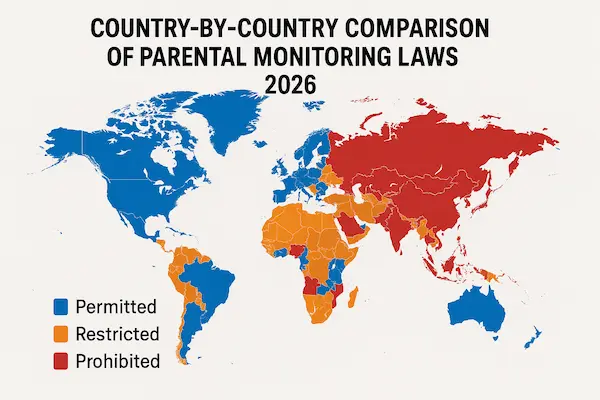
6. Real-World Cases and Legal Lessons (2023 – 2026)
The rapid evolution of Parental Monitoring Laws hasn’t just changed policy — it has reshaped real families’ lives. Between 2023 and 2026, several headline cases around the world defined how far parents can go when tracking their children’s phones. Each one offers an important lesson about privacy, consent, and accountability in the digital-parenting era.
Case 1 – U.S. Family Court and Unauthorized Tracking (2024)
A parent in California installed a hidden GPS tracker on a teenager’s phone without consent. When the child discovered it, the court ruled the act a privacy violation under COPPA 2.0, emphasizing that protection cannot come at the cost of autonomy. The ruling clarified that parental monitoring must be disclosed and justified by safety reasons.
Case 2 – European GDPR Fine for Excessive Monitoring (2025)
In Germany, regulators fined a family €25,000 after an app stored chat data without encryption. The decision reinforced that Parental Monitoring Laws require transparent data processing and proper security measures. Even family use is subject to the same privacy standards as corporate apps.
Case 3 – Asia-Pacific Example: PDPA Breach in Singapore (2026)
A father’s use of a non-compliant tracking tool led to an investigation under Singapore’s updated PDPA 2025. Authorities concluded that uploading a child’s location to foreign servers without consent broke cross-border data-transfer rules. The case prompted local schools to publish parental-tech guidelines for safer monitoring.
Legal and Practical Lessons
-
Always inform and obtain consent before installing monitoring apps.
-
Use tools certified under Parental Monitoring Law standards like COPPA, GDPR, or PDPA.
-
Ensure data encryption and local storage to avoid international privacy breaches.
-
Keep monitoring proportional — safety-driven, not control-driven.
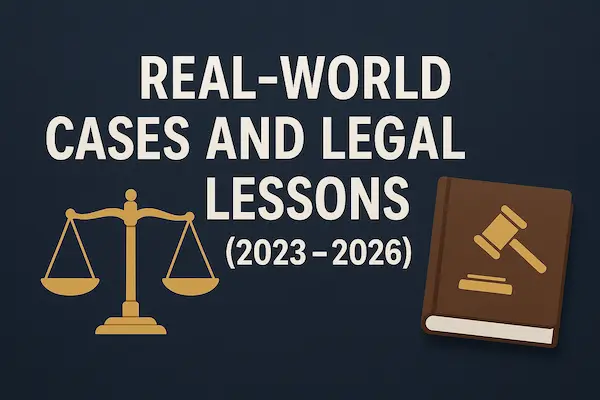
7. How to Stay Compliant When Using a Phone Tracker App
By 2026, compliance is no longer optional — it’s the foundation of responsible digital parenting. New Parental Monitoring Laws require parents to treat tracking apps the same way companies handle customer data: with transparency, consent, and security. Staying compliant protects not only your child’s privacy but also your own legal safety.
1. Obtain Clear Consent
Before installing any tracking app, always explain the purpose to your child. Most laws — from COPPA 2.0 in the U.S. to GDPR-Kids and PDPA 2025 in Asia — demand informed consent when minors’ data is collected. Parents should keep a written or digital record confirming this permission.
2. Use Verified and Compliant Apps
Choose apps that explicitly state compliance with child-data regulations. Look for labels such as COPPA-compliant, GDPR-certified, or PDPA-approved. Legitimate platforms will provide encryption standards (like AES-256), clear privacy policies, and transparent data retention timelines. Avoid tools that store information on foreign or unverified servers.
3. Secure Data and Limit Access
Under global Parental Monitoring Laws, parents are considered data controllers — meaning they’re accountable for how the collected data is used. Always enable two-factor authentication, restrict access to trusted devices, and regularly delete unused data. This ensures compliance and minimizes the risk of leaks or misuse.
4. Follow Updates and Local Rules
Regulations evolve quickly. What’s legal in 2025 may not be compliant in 2027. Subscribe to official updates from government data protection agencies or legal-tech sources. Responsible parents stay informed and adjust monitoring habits as laws change.
8. Future Trends in Parental Monitoring Laws (2026 – 2030)
The next five years will redefine how parents, children, and technology interact. Parental Monitoring Laws are evolving beyond simple rules — they’re becoming dynamic systems that adapt to AI, biometric data, and global digital ethics. For families and developers alike, understanding these upcoming changes will be critical for staying compliant and trustworthy.
1. AI-Based Monitoring and Ethics
Artificial intelligence is transforming how phone tracker apps interpret behavior. Systems can now detect emotional patterns, location routines, and potential risks automatically. Yet lawmakers are cautious. Between 2026 and 2030, new privacy directives in the EU, U.S., and Asia will likely restrict AI-driven profiling of minors unless there’s explicit consent and human oversight. Parents will be required to use AI features transparently — explaining what data is analyzed and why.
2. Biometric and Facial-Data Protection
Emerging parental-control tools now use fingerprint or facial recognition for log-ins and child verification. By 2030, these identifiers will fall under stricter protection similar to medical records. Parental Monitoring Laws are expected to limit biometric storage and demand local encryption instead of cloud uploads. Parents who choose such tools must confirm the vendor’s compliance status and avoid unverified biometric tracking.
3. Toward Global Standardization
A major shift is coming: international coordination. Organizations like the OECD, UNICEF, and ASEAN Digital Council are working toward a unified child-data framework. The goal is to harmonize consent ages, simplify cross-border data transfers, and establish universal standards for parental monitoring apps. By 2030, a single “global compliance code” may help parents understand their rights anywhere in the world.
FAQs – Parental Monitoring Laws 2026
1. Are Parental Monitoring Laws the same in every country?
No. Each nation defines different consent ages, penalties, and data-privacy rules. Always review your local child-data and monitoring acts before using any phone-tracking tool.
2. Can I legally track my child without telling them?
In most regions, no. Secret monitoring violates Parental Monitoring Laws that require informed consent or transparent purpose statements.
3. What’s the legal age for digital consent in 2026?
Usually between 13 and 16. Above that, teens may refuse or must approve ongoing tracking depending on national rules.
4. What makes a tracker app compliant?
It clearly states privacy policies, uses encryption, offers consent workflows, stores data locally or under certified jurisdiction, and supports deletion on request.
5. Are free tracking apps legal?
Many free apps ignore privacy compliance or transfer data abroad. Choose verified tools that meet Parental Monitoring Laws and publish compliance marks.
6. What are the penalties for illegal tracking?
Fines can range from thousands of dollars to multi-million corporate penalties under COPPA 2.0, GDPR-Kids, or PDPA 2025 if parents misuse data.
7. Do Parental Monitoring Laws cover AI and biometrics?
Yes. 2026 updates restrict AI profiling and facial recognition for minors unless explicit consent and human oversight exist.
8. How can parents stay compliant long-term?
Stay informed, document consent, use lawful apps, enable encryption, and update practices as new privacy reforms appear worldwide.
Conclusion – Why Parental Monitoring Laws Matter in 2026
In 2026, Parental Monitoring Laws are no longer just legal guidelines — they are the moral compass of digital parenting. Across continents, governments are reshaping how families use technology, balancing protection with privacy, and ensuring that children grow up safe yet respected in the connected world.
The message is clear: monitoring must be transparent, consensual, and purposeful. Parents who adapt to these principles not only protect their children from online threats but also build trust — the foundation of every healthy digital relationship.
Technology will keep advancing, but so will regulations. Staying informed, choosing compliant tools, and respecting your child’s privacy are the smartest steps any parent can take in 2026 and beyond.
Quick Summary: Parental Monitoring Laws 2026
| Aspect | Global 2026 Standard | Practical Tip for Parents |
|---|---|---|
| Digital Age of Consent | 13–16 years | Always explain and confirm consent before tracking |
| Legal Purpose | Safety, education, or device protection | Avoid covert or excessive monitoring |
| Data Protection | Encryption + transparent storage | Use verified, privacy-certified apps |
| Cross-Border Rules | Consent + legal transfer mechanisms | Keep data on trusted or local servers |
| AI & Biometrics | Human oversight required | Disable unnecessary AI profiling features |
| Penalties | Up to millions in fines | Document consent + privacy compliance |
| Ethical Principle | Safety with respect | Communicate openly with your child |
Protect Your Family the Right Way
Digital parenting in 2026 isn’t about control — it’s about connection and compliance. Before installing any app, make sure it respects your country’s Parental Monitoring Laws, offers clear consent options, and uses secure, encrypted systems.
Choose tools built for safety and legality — platforms that empower parents while preserving a child’s right to privacy.
Start smart. Choose a verified, law-compliant tracker like PhoneTracker247 to monitor responsibly, protect effectively, and stay compliant everywhere you go.